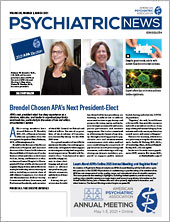“Do you like it?” Ms. M asked, fluffing her newly permed hair. It did seem unbelievable that several months ago, she had been referred for hospice care. At the time, the patient rarely spoke or ate during her frequent discharges and readmissions to the state geriatric psychiatric hospital and the university hospital nearby. Slowly, through collaboration among specialists from geriatric psychiatry, palliative care, and geriatric primary care, her multiple comorbid conditions were addressed, and her complex psychotropic medication regime was simplified. She experienced a remarkable recovery and was now ready to go on living.
Community psychiatrists constantly use the skills acquired during a geriatric psychiatry fellowship, which can allow them to provide more comprehensive care for aging patients with serious mental illness (SMI), most of whom have multiple psychiatric and medical comorbidities.
As the nation’s population ages, so too are individuals living with SMI. These individuals have unique needs that fall at the intersection of the subspecialties of public psychiatry and geriatric psychiatry. Today, many older patients with SMI receive care at public mental health clinics where they are cared for by community psychiatrists and in Assertive Community Treatment programs. However, the shortage of geriatric psychiatrists in this country is well known, and more public-sector psychiatrists with expertise in geriatric psychiatry are needed.
In the last decade, fellowship programs in public and community psychiatry have gained popularity among psychiatry residents. A survey of psychiatry trainees found that most had a significant level of interest in public psychiatry. Since 2006 the number of public and community psychiatry fellowship programs in the United States has expanded from two to 21 programs, according to the American Association for Community Psychiatry. These programs equip trainees with skills needed to navigate increasingly complex public mental health infrastructures to provide care for individuals living with SMI. To provide more comprehensive and high-quality care for the rapidly aging population in the United States, trainees who intend to work in public mental health clinics will benefit from geriatric psychiatry training and should consider completing a postgraduate fellowship in geriatric psychiatry.
Geriatric psychiatry and public psychiatry already overlap significantly. Geriatric psychiatrists care for patients with complex disease presentations that require collaboration with other medical specialists. They work on interdisciplinary teams to navigate complicated behavioral health and social service systems and are often at the forefront of developing innovative systems of care to meet the needs of our nation’s aging population. In many ways, geriatric training is a natural fit for residents interested in working in the public sector.
The challenges that excite individuals interested in public and community psychiatry are the same challenges that exist in the field of geriatric psychiatry: working collaboratively with health care professionals in other disciplines; navigating complex health systems; effectively utilizing local, state, and federal resources; and developing other structural interventions to meet the mental health needs of underserved populations. The overlap is clear. Exposing trainees who have an interest in community and public psychiatry to experiences in geriatric mental health can help alleviate the geriatric workforce shortage and ultimately result in better treatment for our aging SMI population. ■
To learn more about geriatric training and other opportunities in the field, please visit the American Association for Geriatric Psychiatry (AAGP) website
here.
Psychiatry residents and medical students are also encouraged to apply to the AAGP Scholars Program. Both authors are alumni of the AAGP Honors Scholars Program.

